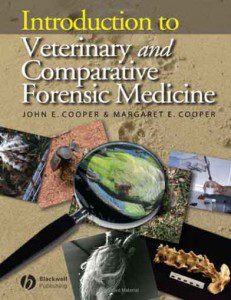
Introduction to Veterinary and Comparative Forensic Medicine
by John E. Cooper, Margaret E. Cooper
April 2008

Introduction to Veterinary and Comparative Forensic Medicine is a ground-breaking book in an emerging new speciality. It reflects the increasing demand for expert opinion by veterinarians and others in courts of law and elsewhere on such matters as:
- wildlife conservation,
- welfare of, and alleged cruelty to, animals,
- insurance, certification and malpractice
- the identification of live and dead species or their derivatives.
It also discusses and analyses current concern over possible links between domestic violence and abuse of animals. Throughout the book the emphasis is on the need for a systematic and thorough approach to forensic work. A particular feature is practical advice, with protocols on dealing with common problems, together with case studies, various appendices and an extensive bibliography.
A vital reference for members of the veterinary profession, lawyers, enforcement bodies and welfare and conservation organisations. The comparative aspects provide an important source of information for those working in human forensic medicine and the biological sciences.
Table of Contents
Dedication.
Foreword.
Authors’ Preface.
Part I: Introduction:.
1. What is forensic medicine?.
2. The special features of veterinary and comparative forensic medicine.
3. The importance and application of animal law.
Part II: Particular Types of Case:.
4. Animal welfare.
5. Conservation and wildlife crime.
Part III: Methodology:.
6. Clinical work.
7. Post-mortem examinations.
8. Laboratory investigations.
9. Site visits and collection of evidence.
10. Collation and analysis of findings and record-keeping.
11. Storage, labelling and presentation of material.
12. Serving as a witness and appearing in court.
13. The future.
Appendix A. Submission and report forms – carcasses, tissues and laboratory samples.
Appendix B. Useful addresses and sources of information.
Appendix C. Glossary of terms.
Appendix D. Some case studies, demonstrating approach and techniques.
Appendix E. Journals, societies and organisations.
Appendix F. Scientific names of species in text.
References and Further Reading.
Index

